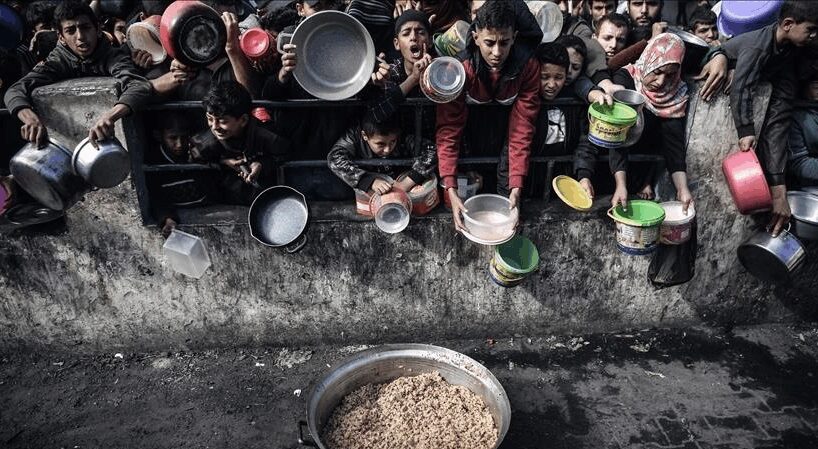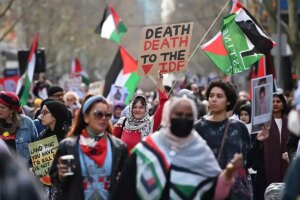
2025-07-29T22:00:07+00:00
font
Enable Reading Mode
A-
A
A+
Shafaq News
Nearly 10% of Gaza’s 2.3 million residents had been
killed or wounded in Israel’s ongoing military campaign, as famine,
displacement, and the systematic destruction of health and economic
infrastructure pushed the enclave toward irreversible collapse.
Gaza’s Health Ministry reported at least 60,034
fatalities and 144,870 injuries since October 7, 2023. More than 30% of those
killed were children, over 16% were women, and 7% elderly—figures that
collectively made up the majority of the dead. However, those numbers were
likely incomplete.
Speaking to Shafaq News, Salah Abdel-Ati, head of the
International Commission to Support the Palestinian People’s Rights, estimated
that over 75,000 had been killed and more than 145,000 wounded, attributing the
underreporting to the destruction of civil registries, mass graves, and
inaccessible neighborhoods.
Of the enclave’s 38 hospitals, 36 had been destroyed or
disabled, leaving only two partially functional. According to the World Health
Organization, fewer than 15% of Gaza’s primary care centers continued to
operate — many of which were unreachable, overwhelmed, or lacked essential
supplies.
Abdel-Ati emphasized that patients were now succumbing
to otherwise treatable conditions, as services such as dialysis, surgery,
maternity care, and cancer treatment vanished in many parts of the territory.
Fuel shortages and supply blockades pushed the remaining health sector to the
brink.
“The collapse of the healthcare system was causing
preventable deaths every day,” he warned.
Turning to the economic toll, Abdel-Ati noted that
“policies of starvation and the prevention of imports pushed prices far beyond
people’s ability to pay.” He further revealed that more than 140,000 tons of
explosives had leveled 95% of Gaza’s buildings and infrastructure, displacing
over 90% of the population.
Earlier, the Palestinian Businessmen Association
reported that over 90% of Gaza’s factories, markets, workshops, and utilities
suffered damage or destruction, with the United Nations Conference on Trade and
Development further estimating that economic losses had already exceeded $18
billion.
Fishing and agriculture — both critical to local
livelihoods — had also been decimated. Fishing fleets were inoperable, and
farmlands were razed or contaminated. Flour, when available, costs more than
$30 per kilogram.
“There were no jobs, no income, and barely any food,”
Abdel-Ati added, painting a bleak picture of survival on the brink.
Ceasefire Efforts Falter
As conditions on the ground deteriorated, diplomatic
efforts toward a ceasefire stalled, casting doubt on the near-term prospects
for de-escalation. Khalil al-Hayya, Hamas leader, affirmed that his movement
had exercised “maximum flexibility” throughout 22 months of indirect
negotiations, participating in all mediation rounds initiated by regional and
international actors.
While Hamas engaged in tough talks without compromising
core principles, al-Hayya expressed surprise at Israel’s sudden withdrawal and
the American envoy’s alignment with the occupation.
“They are prolonging the war and increasing pressure on
civilians,” he argued.
Although no official announcement declared the collapse
of talks, multiple sources confirmed recent progress had stalled. Analysts
point to political considerations as a key factor behind the breakdown, rather
than mere deadlock.
Egyptian military analyst General Samir Farag traced the
stalemate to Israeli domestic politics. He explained to Shafaq News that the
Israeli Prime Minister Benjamin Netanyahu refuses any ceasefire out of fear it
could lead to his removal from office and prosecution over several cases.
With no results on freeing hostages, defeating Hamas, or
seizing Gaza, Farag believes Israel is prolonging the conflict to shift
political pressure and exhaust Hamas militarily.
“There is a clear effort to pressure Hamas through
starvation and exhaustion, while exploiting internal Palestinian divisions,”
Farag added, highlighting how the Palestinian Authority in Ramallah continues
to view Hamas as the root of the crisis, demanding its exit from Gaza and the
release of remaining hostages.
Written and edited by Shafaq New staff.





